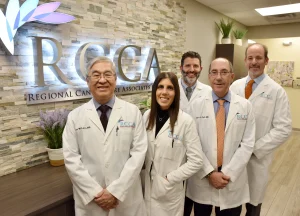
Top Honor: RCCA Moorestown Doctors Named Best for Women by South Jersey Magazine
Patients receiving treatment from Regional Cancer Care Associates in Moorestown are in good hands. Five of its physicians — Dr. Seth Berk, Dr. Maurice Cairoli, Dr.
HIPAA Alert: Potential Data Breach Learn More
Questions on Oncology, Hematology and/or Infusion Clinical Services due to COVID-19 Crisis – CALL 833-698-1623
Important Information for Our Patients Regarding the Coronavirus.
RCCA Providing Area Cancer Patients with Access to Care During Coronavirus Outbreak
RCCA Offering Patients Virtual Visits During Coronavirus Pandemic
Smoking is the leading risk factor for lung cancer, and is associated with nearly 90 percent of all cases in the United States. Smoking not only increases the likelihood of developing lung cancer – it also increases the chances of dying from the disease. As a result, much of the attention given to lung cancer risk factors is focused on cigarette smoking, but there are several other risk factors for lung cancer that people need to know about.
Regional Cancer Care Associates (RCCA) is one of the nation’s largest oncology networks, with a highly experienced team of compassionate medical oncologists and hematologists treating a range of cancers and blood disorders, including lung cancer. In this article, RCCA oncologists outline the factors beyond smoking that can increase a person’s risk of developing lung cancer.

Radon exposure is the second most common cause of lung cancer. Radon is a natural radioactive gas present in rocks and soil due to the breakdown of uranium. Although it is rare to encounter dangerous levels of radon outdoors, it becomes more of a threat indoors, where levels can be concentrated in basements and other areas. Radon is colorless and odorless, making it difficult to detect. The gas is found in many homes and other buildings in the U.S.
According to the U.S. Environmental Protection Agency, radon is responsible for about 21,000 lung cancer deaths every year. Although people who have never smoked can die from lung cancer due to radon exposure, the combined risk of smoking and radon exposure compounds the likelihood of developing lung cancer.
The harmful effects of tobacco smoke are not limited to smokers alone. Family members of smokers or others who live in the same household may inhale the smoke that lingers in the air. This phenomenon is called secondhand smoke, and it can increase one’s risk of developing lung cancer. It is the third most common cause of the disease.
Air pollution has a relatively modest impact on a person’s risk for lung cancer. Particles from industrial exhaust and microscopic liquids and solids accumulate in the atmosphere and can enter the lungs through breathing. Air pollution is of special concern for people in larger cities, especially if they live near highways or other roads with heavy traffic.
The risk of developing lung cancer due to air pollution is significantly lower than the risk from cigarette smoking, but the effects of climate change have increased concern about the role of pollution. A study from the American Lung Association finds that one in three Americans live in a place where air pollution is at unhealthy levels.
Asbestos refers to a group of naturally occurring minerals that resist heat and corrosion. Because of these properties, asbestos has been used in the production of many commercial goods, such as insulation and automotive brakes. Individuals who work in environments where asbestos is present, such as mines, textile plants, and mills, are at elevated risk of developing lung cancer and mesothelioma, another type of cancer. They are also more likely than other people to die of lung cancer.
The use of asbestos has declined over the years due to government regulations, but the substance is still found in many older structures. Generally, asbestos is not considered harmful unless released into the atmosphere during demolition or renovations. The degree to which low-level, short-term exposure to asbestos may contribute to lung cancer risk is unclear.
In addition to radon and asbestos, several other chemicals, materials, and substances can increase the risk of lung cancer. Many individuals are exposed to these substances because of their work. For instance, radioactive ores like uranium, which is found in rocks, some water sources, and uranium mines, can compound one’s risk. Military veterans and munitions plant employees exposed to battlefield emissions, weapons production, and nuclear propulsion may also be at increased risk for lung cancer. Examples of dangerous chemicals include:
People with a close family member diagnosed with lung cancer are at increased risk of developing the disease themselves. The risk is greater if a family member was first diagnosed when younger than 50 years old. People with family members who have or have had lung cancer should mention this fact to their doctors to explore whether preventive screenings may be worthwhile.
Additionally, individuals who had lung cancer at one point in their own lives are more likely than other people to develop lung cancer in the future. Smoking will increase this risk.
Radiation therapy is used to treat a range of cancers, including lung cancer. However, receiving radiation therapy to the chest for a different cancer or disease can increase the chance of lung cancer developing later. Breast cancer is commonly treated with radiation therapy to the chest, so patients who have been treated for breast cancer may wish to consult their doctors about their risk of lung cancer.
The heightened risk of lung cancer from smoking has less to do with the cigarette itself than with the tobacco it contains. In keeping with this, using cigars, pipes, and similar tobacco products also is associated with a higher risk for lung cancer.
There is growing interest in understanding the relationship between lung cancer risk and smoking marijuana. Marijuana smoke contains many of the same substances found in tobacco smoke that cause cancer. People tend to smoke marijuana cigarettes to the end, which is the highest amount of tar is found. When smoking marijuana, people often inhale deeply, therefore holding the smoke in the lungs for an extended period. This provides the cancer-causing substances in tar more time to affect the lungs.
Two issues limit medical researchers’ ability to determine the impact marijuana smoking has on lung cancer risk. First, people who smoke marijuana typically do so less often per week than those who smoke cigarettes. Second, with marijuana still illegal in some areas, collecting data about its use is challenging. More research is required to make informed statements about marijuana smoking and cancer risk.
E-cigarettes provide an alternative to cigarette smoking in which the user receives nicotine via an electronic device. Because e-cigarettes are relatively new, more research is needed to establish the effects their use may have on the lungs.
Informing your doctor of any lung cancer risk factors you may have is important to helping the physician decide if preventive screening is in order. Early detection of lung cancer is critical to treating the disease in its earliest stages, when the best outcomes often can be achieved. The following are common lung cancer treatments:
While smoking plays a significant role in determining a person’s risk for lung cancer, it is not the only factor to consider. Exposure to certain chemicals, family history, past treatments, and even the effects of secondhand smoke can all contribute to risk for the disease.
Patients seeking treatment for lung cancer can find compassionate and personalized care from the oncology team at RCCA. These skilled medical oncologists provide the latest, evidence-based therapies to patients in New Jersey, Connecticut, Maryland, and the Washington, D.C., area. For more information about lung cancer, including signs and symptoms, contact Regional Cancer Care Associates or schedule an appointment at one of the nearest locations.
For more information or to schedule an appointment,
call 844-346-7222. You can also schedule an appointment by calling the RCCA location nearest you.

Patients receiving treatment from Regional Cancer Care Associates in Moorestown are in good hands. Five of its physicians — Dr. Seth Berk, Dr. Maurice Cairoli, Dr.

The world of cancer treatment is rapidly evolving. New therapies are being discovered, and existing ones have improved, resulting in better patient outcomes. Regional Cancer

The imaging tests were negative, but Elizabeth Whalen knew something was wrong. Having survived pancreatic cancer and breast cancer, the Cape May Court House resident was

Regional Cancer Care Associates is one of fewer than 200 medical practices in the country selected to participate in the Oncology Care Model (OCM); a recent Medicare initiative aimed at improving care coordination and access to and quality of care for Medicare beneficiaries undergoing chemotherapy treatment.